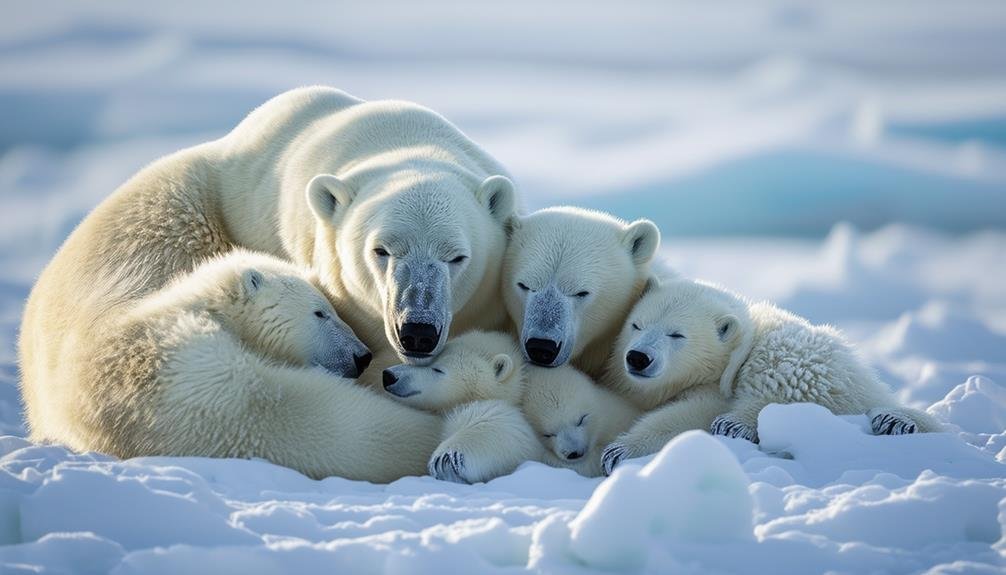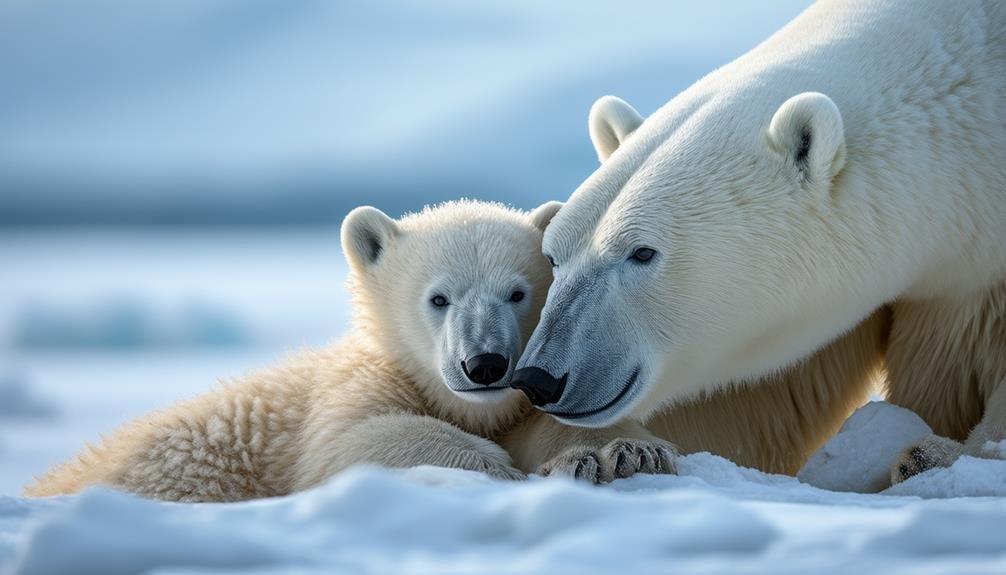Polar bear cubs, born blind and toothless in sheltering snow dens, are highly dependent on their mothers for survival during the harsh winter. The dens, constructed in snowdrifts, offer protection from severe Arctic conditions and predators. Inside, cubs nurse on nutrient-rich milk, essential for their early development and warmth. The mother, fasting and relying on her fat reserves, provides continuous care and protection. These maternal behaviors and the unique adaptations of cubs, such as thick fur and efficient heat retention, are critical for their survival in this extreme environment. Discover more about the intricate survival strategies of polar bears.
Main Points
- Polar bear cubs are born blind and toothless in protective snow dens.
- Cubs rely solely on their mother's rich milk for nourishment and warmth.
- Mother bears fast during denning, relying on fat reserves for survival.
- Dens provide essential protection from the extreme Arctic climate.
- Cubs develop thick fur and a high surface area to volume ratio for insulation.
Birth and Early Development
Polar bear cubs are born in the shelter of snow dens during the harsh winter months, emerging into the world blind, toothless, and highly vulnerable. Female polar bears retreat into these dens to give birth and provide a secure environment for their newborns. The cubs' initial days are spent nursing, receiving essential nourishment from their mothers. This period of nursing in the dens is vital for the cubs' early development, as they are entirely dependent on their mothers for warmth and sustenance.
During the winter, female polar bears endure significant weight loss as they rely on their body fat reserves to produce milk. This self-sacrifice is important for the cubs' survival, as the harsh external conditions can be fatal for the young and defenseless. The cubs' eyes and teeth begin to develop gradually while they remain in the safety of the den.
Denning Habits
Denning habits of polar bears are vital for the survival and development of their cubs during the winter months. Polar bear cubs are born in snow dens, which provide a safe and stable environment essential for their early life stages. These dens are meticulously constructed by mother polar bears, who dig into snowdrifts to create a secure and insulated space.
During the denning period, mother polar bears undergo fasting, relying on their fat reserves to sustain them. This is a period of intense maternal dedication, as newborn cubs are born blind, toothless, and completely dependent on their mothers for warmth and nourishment. The snow dens offer protection from the harsh Arctic climate, allowing the cubs to grow and develop in relative safety.
As the weeks progress, the den becomes a nurturing haven where the cubs can slowly gain strength. The protective environment guarantees that they are shielded from predators and extreme weather until they are robust enough to venture out. Typically, polar bear cubs remain in the den until spring, when they are finally ready to explore the outside world under the vigilant care of their mother. This denning phase is pivotal, setting the foundation for their future survival.
Maternal Care

The nurturing care provided by mother polar bears during the denning period is essential to the survival of their vulnerable cubs in the harsh Arctic environment. During this critical time, mother polar bears create dens in the snow to offer warmth, protection, and nourishment to their cubs. The den acts as a sanctuary where the cubs, born blind and toothless, receive constant care and guidance.
Maternal care involves several key aspects:
| Aspect | Description |
|---|---|
| Warmth | The mother's body heat maintains a suitable temperature in the den. |
| Nourishment | Cubs rely entirely on their mother's milk for sustenance. |
| Protection | The den shields cubs from predators and severe weather. |
The bond formed between the mother polar bear and her cubs is crucial for their survival. This connection ensures that the cubs learn essential skills and behaviors necessary for their future independence. Maternal instincts drive the mother to prioritize the health and growth of her cubs, often at the expense of her own well-being. This unwavering commitment underscores the critical role of maternal care in the harsh winter environment, where the survival of the cubs hinges on the mother's dedication and sacrifice.
Adaptations for Cold
Adaptations for cold are necessary for the survival of polar bear cubs in the extreme Arctic environment. Polar bears have evolved a range of cold adaptations to guarantee their cubs can withstand the harsh conditions of the Arctic winter. Newborn cubs are equipped with a thick coat of fur, providing an initial layer of insulation against the frigid temperatures. This thick fur is complemented by the cubs' high ratio of body surface area to volume, which aids in retaining heat more efficiently.
Maternity dens play a vital role in shielding the cubs from the brutal elements. These dens offer a warm and secure environment where cubs can develop without direct exposure to the severe cold. Additionally, the rich milk provided by the mother is essential. It is packed with fat reserves, which are necessary for the cubs to maintain their body heat and energy levels during the winter months.
The cubs' dependency on their mother for warmth, protection, and nourishment underscores the significance of these cold adaptations. By staying within the confines of the maternity den and relying on the rich milk, polar bear cubs can survive and thrive despite the Arctic winter's formidable challenges.
Survival Challenges

Polar bear cubs face numerous survival challenges during the harsh Arctic winter, from extreme cold and food scarcity to the need for constant maternal care. Born vulnerable, blind, and toothless in snow dens, the cubs rely entirely on their mothers for warmth, protection, and nourishment. Denning is a critical period when the mother polar bear fasts, dedicating her energy to nursing and safeguarding her offspring. The extreme cold of the Arctic environment poses a significant threat to the cubs, who are ill-equipped to withstand the frigid temperatures without their mother's warmth.
Food scarcity further complicates survival, as the mother must balance her own energy reserves while ensuring the cubs receive adequate milk. This period of fasting and limited food intake can last several months, making the mother cub bond crucial for the cubs' survival. Through this bond, cubs learn essential skills for Arctic life, including hunting and finding their way in their icy habitat. The initial months are especially precarious, as the cubs are highly vulnerable to environmental threats and potential predators. The mother's vigilance and care are paramount, providing the foundation necessary for the cubs to eventually thrive in their formidable Arctic surroundings.
How Does a Polar Bear Cub’s Winter Diet Contribute to Its Unique Development?
A polar bear cub’s winter diet is crucial for its development, providing essential nutrients needed for growth and survival. Feeding mainly on seals, these young bears accumulate the fat reserves required to endure harsh conditions. Seals are among the best foods for polar bears, supplying them with the necessary energy and insulation.
Conclusion
Polar bear cubs exhibit unique characteristics in winter, shaped by their birth and early development, denning habits, and maternal care. These factors, combined with specialized adaptations for cold environments, enable survival in harsh Arctic conditions. However, cubs face significant survival challenges, including climate change and habitat loss. Understanding these elements is essential for conservation efforts, as they highlight the resilience and vulnerability of polar bear cubs during this critical period of their life cycle.


